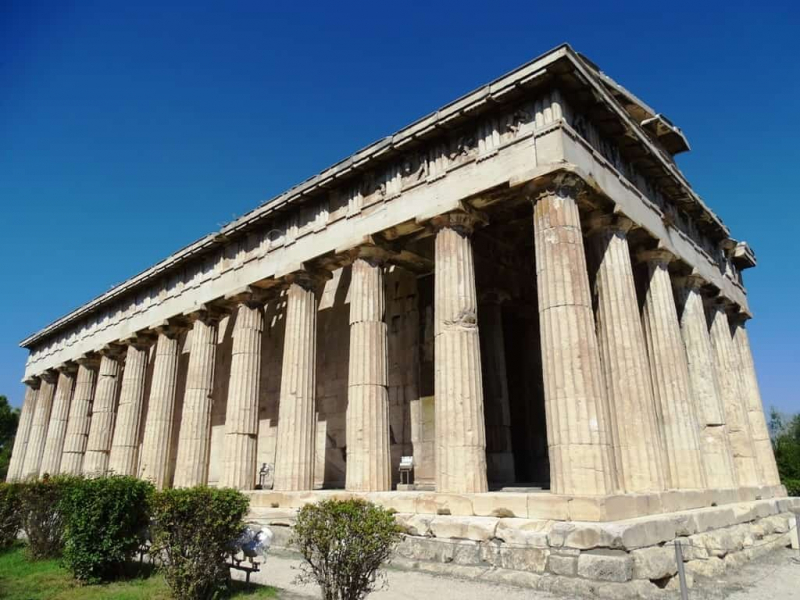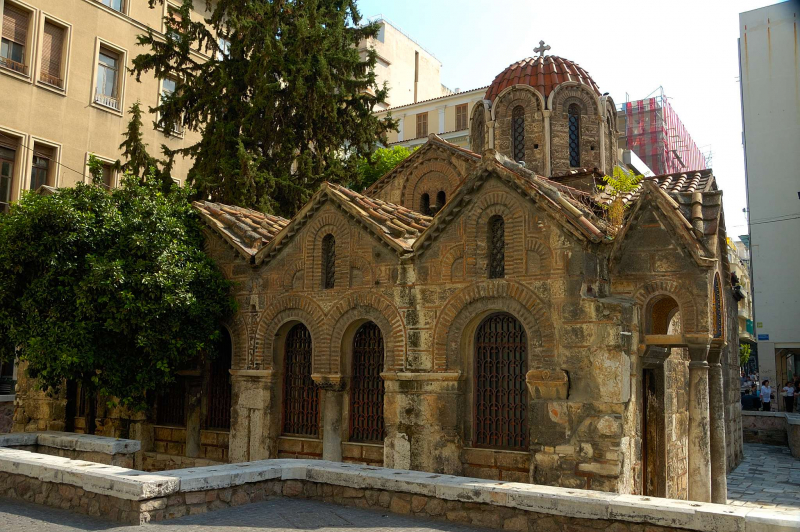Top 13 Best Things to Do in Athens
As the birthplace of modern Western civilization, sprawling Athens has enough neoclassical buildings to keep you busy for a week. But go beyond the Parthenon ... read more...and you'll discover a more youthful side to the city with new art galleries, languid café culture, and outdoor cinemas. Let's find out the top of the best things to do in Athens.
-
It is impossible to visit Greece without seeing the Acropolis. One of the oldest towns in the world, Athens has been dominated by the Acropolis for more than 2500 years, it is the historical core of Athens. So it only seems sensible that visiting the Acropolis is among the most sought-after activities in Athens. To avoid crowds, you should visit the Acropolis early in the morning or late in the day.
The Parthenon is the most famous of the ancient ruins of the Acropolis. It is the symbol of democracy dominating the hill of the Acropolis and dates back to the 5th century BC. But the Acropolis is filled with archeological wonders besides the Parthenon. On the grounds, you will also see The Temple of Athena Nike, and the Odeon of Herodes Atticus theatre. The Athena Temple The temple of Nike is devoted to the goddesses Nike and Athena. Despite being the smallest of the Acropolis' temples, Athena Nike's perch atop a lofty rock is one of the favorited locations. To avoid lines, purchase skip-the-line tickets in advance.
The Propylea Temple of Nike, the Erechtheion Temple, and you must see the Dionysus Theater are further monuments worth visiting. Don't forget to see the Asclepius temple and Herodes Atticus' Odeon too.
Opening hours: 8 am to 8 pm last admission 7:30
Entrance fee: 10€ for adults 25+. 5€ for students from non-EU countries, for young persons under 24 years old from non-EU countries. Free entrance for guests under 24 years and students from EU countries all year round.
timeout.com 
Wikipedia -
The work of Swiss architect Bernard Tschumi, the Acropolis Museum on the southeast slope and was unveiled in 2009 to present the many thousands of artifacts discovered on the archaeological site of the Acropolis.
The new Acropolis Museum's expansive galleries are filled with natural light, which highlights the valuable artifacts that have been brought here for storage after being taken from the hill.
The highlight of the museum is the top-floor glass atrium, where a 161-meter-long frieze from around the top of the Parthenon is installed at eye level so that visitors can see all of its intricate details and get a better sense of its enormous scale (with the exception of the portion still kept in the British Museum).
Visitors are guided chronologically through the ages on three floors, beginning with the archaic discoveries made on the hill in a sizable trapezoidal hall that also contains artifacts from the Erechtheion, the Propylaea doorway, and the Temple of Athena Nike. After that, you ascend to a hall with the same size, column spacing, and orientation as the temple to gaze in awe at the Parthenon's marble pediments and frieze (including metopes).
Opening hours: The Acropolis Museum is open daily. Hours vary by season. From April 1 to October 31, the museum opens at 8 am and closes between 4 pm and 8 pm, depending on the day of the week.
Entrance fee: €10 April 1 to October 31; €5 November 1 to March 31
Acropolis Tickets 
Headout -
The theater in Athens that is located at the base of the Acropolis is called the Odeon of Herodes Atticus. It still accommodates well-known performers today, including Sting in 2018 and the Foo Fighters in 2017. The Athenian Magnate Herodes Atticus had this Roman-era performance hall built in 161 AD, probably in honor of his late wife Aspasia Annia Regilla.
Otto of Greece observed the first excavation, which was conducted in 1848 by the archaeologist Kyriakos Pittakis and the writer Alexandros Rizos Rangavis. The stone levels of the theater were reconstructed in the 1950s using the same marble from Mount Pentelicus as before.
It is a once-in-a-lifetime experience to watch a concert in the oldest of venues among ancient ruins. The Odeon of Herodes Atticus is not only historic, and intimate and every seat offers great views of the stage. As part of the Epidaurus Festival every summer, the Odeon hosts dozens of concerts. Don’t be afraid to attend theatre events. Unless noted specifically, theater shows will have English subtitles.
Opening hour: The performances start at 21:00 and with a half hour intermission you should expect end by 23:30 to 24:00.
Entrance fee: 20 Euros (1598 INR) or a reduced 10 Euros (799 INR)

aefestival.gr 
Explore Greece -
One of Athens' best-preserved ancient ruins is the Temple of Hephaestus. Some consider this to be even more spectacular than the Parthenon, and it is situated inside the walls of the Ancient Agora. If you enjoy Greek architecture, you should visit the Temple of Hephaestus in Athens because of its stunning features and tall fluted columns.
The adjacent Agora was established in the sixth century BC when the Ancient Agora of Athens was first used as a gathering spot. The Temple of Hephaestus is best visited in the morning, like most of the temples in Athens. You will avoid the hordes of tourists who arrive later in the day and enjoy better lighting and a cooler temperature.
Stoa of Attalos was restored in 1953 – 1956 and today it is a museum that houses sculptures and exhibits of Ancient Agora. There are also remnants from the ancient ruins of the Temple of Hephaestus.
A guided tour of Ancient Agora is one of the best ways to visit the Temple of Hephaestus. You’ll visit the Greek temple as well as the church of the 12 Apostles, the Temple of Apollo Patroos, the Stoa of Zeus, and the Altar of Zeus. The tour ends at the Attalos Museum to tour its ancient artifacts.Opening hours: from 8 a.m. to 3 p.m.
Entrance fee: 10 euros (April – October) or 5 euros (November – March)

Greece Travel Ideas 
greece tour hub -
Greek meze is a beloved food experience and a tradition that dates back to the ancient world in Greece. It's the ideal and hassle-free way to catch up with friends over a couple of great plates of food and some wine or spirits. Meze is a wonderful way to experience the diverse flavors and textures of Greek food because it is the meal itself, not just an appetizer to a larger meal.
Traditional Greek food is very simple and relies on high-quality fresh ingredients. Greeks eat family style, with a large number of small dishes, called meze, and everyone at the table shares that. “Meze” means taste or small bite. Like the food itself, eating Meze is a casual affair. Greeks are not shy about grabbing food from the shared plates with a fork, or with their fingers. It starts with the Greek salad (tomatoes, feta, cucumber, onion, peppers, olives) and dips (fava, tzatziki) and then leads to meat and fish dishes, and side dishes like wild greens and fried potatoes.
Never forget to squeeze some lemon juice into virtually everything, even the typical beverages like raki, ouzo, and house wine. Any taverna will provide these nibbles, while new variations on the classic meze include Barbounaki in Kolonaki and Seychelles in Metaxourgheio.

Pinterest 
Taste -
Sitting back and unwinding while admiring the Acropolis and city lights is one of the nicest things to do in Athens at night. For memorable evenings in the city, visit one of the amazing rooftop bars in Athens.
You need to have a specialty cocktail, beer, or glass of wine on a rooftop patio for the greatest nighttime view of the Acropolis! You'll visit three different rooftop bars as part of this enjoyable local experience and have a fantastic time drinking, eating, and chatting with new people. This Athens wine-tasting tour of the Acropolis brings you to a rooftop restaurant with stunning views of the monument, where you can sample Greek wine while also enjoying tasty tapas.
All of the tables are reserved ahead of time, so you won’t have to wait in line at all. If you’re looking for cool things to do in Athens at night, this is a good option.
Some of the best rooftop bars in Athens include The Terrace Floor at Syntagma Square, Novotel Athens with a rooftop pool bar, Couleur Locale in Monastiraki, The Sky Lounge at Melia in the city center, and the Air Lounge Roof bar in Kotzia Square.
This is Athens 
Pinterest -
This is a typical outdoor market, complete with yelling sellers and the associated odors. Greece is a wonderful place to visit even if you don't buy anything because the fruits there look and smell delicious.
Animal heads and corpses hang from hooks in front of onlookers, and butchers slice the meat in open booths, so this is not a place for the easily alarmed. Even if your stomach is sensitive, go to the vegetable section of the market and sample the olives there. Visit Miran for a look at the history of Athens and to enjoy some of their superb cured meats.
The other thing to note is that most of the vendors don’t speak English, but you can point to items that you’re interested in and use sign language (or a translation app).
Every day except Sunday, you can experience the buzz of the largest market in Athens. Athens Central Market extends to both sides of Athinas Street, with vegetables and olives sold on one side, and meat and fish on the other.Hours: daily, except Sunday 7 am – 6 pm
Location: Athinas 42
Pinterest 
TripAdvisor -
Located under the shadow of the Acropolis, Monastiraki is a unique neighborhood that has been inhabited for six thousand consecutive years. It is among the oldest, most historic, and most important neighborhoods in Western Culture. The name “Monastiraki” was established during the Greek Revolution against the Ottoman Occupation.
Monastiraki Square is a bustling meeting place located in the heart of Athens. Located beneath the Acropolis, Monastiraki Square is one of the oldest neighborhoods in Athens. With walking streets, cafes and patios it is a great place to relax and take a stroll for an afternoon. In Monastiraki, you’ll find the archeological site of Ancient Agora.
If you sit in Monastiraki Square long enough, you will see everyone in Athens walk by. This is the place to watch tourists and locals interact. It is also a historic site with a 9th-century church, and a 19th-century mosque, and in the subway station are antiques found during the building of the metro. This is one of the most bustling places in Athens and chilling out here is one of the best things to do.
Opening hours: Sunday - Saturday: 12:00 AM - 11:59 PM

Athens Insiders 
Itinari -
This is one of the best things to do in Athens. You must be in Athens on a Sunday if you want to see this weekly event. The Parliament Building in Syntagma is the location of the Changing of the Guard. It starts at 11:00 am and is open to the public.
While the guards do rotate every hour, the ritual is more elaborate and there are more guards on duty on Sundays at 11:00 than usual. They also wear the traditional Greek uniform. In Athens, Sundays are the ideal day to witness the changing of the guard. They are actually highly skilled troops known as the Evezone, despite their somewhat peculiar appearance. One of the best free activities in Athens is this.
This city tour not only includes stops at Athens’s top attractions to visit the Acropolis, Parthenon, Nike Temple, and more, but you’ll also see other lesser-known sites. Meet in the city center at the House of Parliament and see the Tomb of the Unknown Soldier, the National Garden, Zeus Temple, and Hadrians’s Arch while you learn of the first Olympic Games and ancient Greek History.
Time: 11:00 am
Entrance fee: freeIstván Mága 
Yatzer -
On Sundays, the massive Monastiraki Flea Market, which is located between the Monastiraki and Thisseio areas, is packed with people seeking a deal. The renowned Monastiraki Flea Market in Athens offers just about anything you can imagine. It's a great spot to find one-of-a-kind mementos of your time in Athens thanks to the tables piled high with vintage goods and odd collectibles.
Here, traders open up their second-hand stores to flog a jumble of flea-market finds, vintage clothing, and oddities ranging from vintage magazines punctuated with bold Greek lettering to mid-century furniture and strange bric-a-brac. Look hard enough and you’ll find some buried treasure (and if not some insight into how modern Greeks have furnished their homes for the past 60 years).
You must arrive early because the crowds become impossible after around 11 am, and there aren't many tables available at the various cafés and restaurants in the neighborhood if you want to take a break. If you're looking to buy a specific item, you can either aimlessly meander about it or find someone who understands the flea market and can take you around. The flea market isn't truly a flea market in many areas. It is a cluster of little stores, most of which are tourist traps selling the same goods as Adrianou Street in the Plaka.
Opening hours: 08:00 am - 06:00 pm

GPSmyCity Earth Sound Walks -
In the touching distance from Psiri and Plaka, the National Garden is a welcome green buffer between ancient Athens and the modern sea of concrete. Commissioned by Queen Amalia in 1838 as the royal garden of the adjacent palace (which is now the Greek Parliament building), the National Garden is a picturesque respite from the busy city.
The National Garden was formerly the Royal Garden, opening up to the south of the Old Royal Palace and ordered by Amalia of Oldenburg at the end of the 1830s.
One of the few shaded areas in the middle, it's wonderful for a stroll and for viewing ruins like columns and Corinthian capitals. The park's entrance is marked by the 12 palm trees the queen planted and is located on Leoforos Amalias (named for her), just a short distance from Syntagma Square. Bring your kids to the two ponds to see the turtles and ducks, and spend a few moments relaxing while lounging beneath the pergolas and avenue of tall palm trees. In addition to a botanical museum, the park features a small zoo featuring peacocks, birds of prey, wolves, and monkeys. And this being Athens, don’t be surprised to bump into some traces of the ancient city, like mosaics and columns.
Opening hours: from dawn to evening
Entrance fee: free
Athens Tourist Information 
Greek Boston -
The Holy Virgin Church in Kapnikarea is one of Athens' oldest Byzantine churches. On the site of an earlier shrine that had been built by Eudokia of Athens, the wife of the Byzantine Emperor Theodosius II, it is thought that it was constructed around 1050. It is an Orthodox church and is situated on Ermou Street, the busiest and most commercial street in the old district of the Greek city. Kapnikarea was built over an ancient Greek pagan temple, most likely dedicated to Demeter or Athena, as was common with early Christian churches.
The church amazes by itself. At least, by the incredible atmosphere that you feel as soon as you cross the threshold of the shrine. The light from the small windows reflects on the holy faces, and they seem to begin to shimmer. In addition, the abundance of stone makes the interior inscrutable and majestic. You just admire how this mysterious quiet place shares a neighborhood with one of the noisiest streets in Athens. The colorful iconography in the interior is recent and was composed by the painter Photis Kontoglou in the mid-20th century, but there’s also older decoration in the church’s friezes and the sculpted column capitals inside.
Opening hours: from 10:00 am to 18:00 pm
Entrance fee: free

Trip.com 
wordscene - WordPress.com -
The Byzantine and Christian Museum of Athens is one of the most fascinating national museums you can visit. In order to gather, research, preserve, and display the Byzantine and Post-Byzantine cultural legacy in the Hellenic region, the organization was founded in the early 20th century (1914).
The Byzantine and Christian Museum, which had been housed in the Neo-Renaissance Villa Ilissia since 1848, debuted in 1914 and underwent renovations in time for the 2004 Summer Olympics. Sculptures, icons, frescoes, jewels, pieces of architecture, religious robes, manuscripts, books, and mosaics are among the mesmerizing collection.You’ll get to know its landmark events, like when Christianity was made legal by Constantine, and Roman power shifted from Rome to Constantinople in the 4th century. The museum also studies the decline of Byzantine power, and how Venetian-controlled territories with cosmopolitan populations helped lay the path for the Renaissance in Europe.
Opening hours: From November to March the opening hours are from 08:30 - 15:30 (09:00 - 16:00 for the major ones) and are extended during the summer ( April - October )
Entrance fee: 4€ November through March, 8€ April through October.

Byzantine and Christian Museum 
Athsenser


































